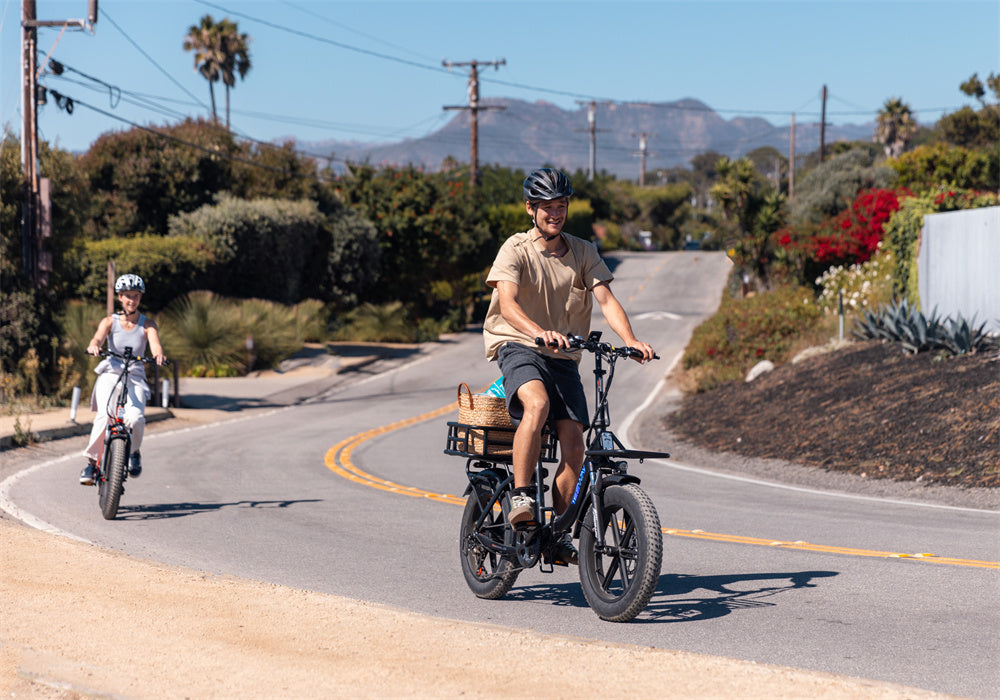Torque sensors and cadence sensors are usually the ones everyone talks about.
They’re the go-to topics when discussing how your Ebike responds to your pedaling.
Even though it’s less talked about, the Hall sensor plays a crucial role in ensuring your electric bike operates smoothly.
In this article, we’ll go through what the Hall sensor does and why it’s an essential part of your riding experience.

How Does a Hall Sensor Operate
At its core, a Hall sensor is a small but essential part of the electric motor in electric bike.
This sensor is responsible for detecting the position of the rotor relative to the stator inside the motor, utilizing the Hall effect—a phenomenon where a magnetic field generates a voltage perpendicular to the current flowing through a conductor.
The operation of a Hall sensor is based on its ability to detect changes in magnetic fields.
The rotor of an ebike motor, which contains magnets, rotates and passes these magnets by the Hall sensor fixed to the stator.
The Hall sensor picks up the magnetic fields from these magnets and sends signals to the Ebike's controller, providing real-time data about the rotor's position.
This data is indispensable for the controller to adjust the current sent to the motor's coils, ensuring that the motor's magnetic fields interact at precisely the right times.
This precise timing is crucial for optimal motor operation—without it, the motor could become inefficient, leading to jerky movements or even potential damage.
In modern eBikes, these sensors are typically digital, meaning they convert the detected magnetic field into a clear binary signal (on or off) that the controller can easily process.
The precise and rapid detection of rotor position allows for finely tuned motor control, essential for the smooth operation of the electric bicycle at varying speeds and under different load conditions.
Moreover, Hall sensors come in various types, including unipolar, bipolar, and omnipolar sensors.
Each type has its specific application depending on the design and requirements of the motor.
Unipolar Hall sensors are activated by one magnetic pole (usually the south pole), while bipolar sensors require both poles to operate.
SEE ALSO Ebike speed malfunction | Fix Sensor Error Problem
Impact on Ebike Performance
Precision in Motor Control
The primary function of the Hall sensor in electric bike is to enable the motor controller to manage the motor's operation with precision.
The sensor’s ability to detect the exact position of the rotor allows the controller to fine-tune the timing of the electrical pulses delivered to the motor's coils.
This precise control ensures the motor runs smoothly, regardless of the speed or the load the Ebike is under.
In practical terms, this means that the Hall sensor helps ensure that your electric bike accelerates smoothly and operates efficiently across various conditions.
It’s the difference between a ride that feels seamless and one that’s plagued with uneven power delivery.
During steep climbs or rapid acceleration, the motor requires immediate and accurate information about the rotor's position to adjust the torque accordingly.
The Hall sensor ensures that this information is delivered in real-time, allowing the motor to respond swiftly to changes in riding conditions.
This responsiveness is particularly crucial for riders who rely on their eBikes for demanding tasks, such as off-road biking or heavy cargo transport.
Boost Efficiency and Reducing Power Consumption
In a world where battery life and efficiency are crucial, the Hall sensor’s role cannot be overstated.
By delivering accurate positional information to the controller, the Hall sensor ensures that the motor operates with maximum efficiency, reducing unnecessary power consumption.
This efficient operation translates directly to longer battery life, allowing your ebike to cover more distance on a single charge.
For riders, this means more time enjoying the journey and less time worrying about running out of power. It’s the kind of efficiency that makes eBikes not only a practical choice for commuting but also a reliable companion for longer rides.
The efficiency gains provided by Hall sensors contribute to reduced heat generation within the motor.
Overheating is a common issue in high-performance eBikes, especially during extended periods of heavy use.
Enhance Safety and Reliability
Safety is always a top priority, and the Hall sensor contributes significantly to the safe operation of an eBike.
By ensuring that the motor operates smoothly and without interruption, the Hall sensor helps prevent unexpected jolts or stalls that could lead to accidents.
In the event of a malfunction, such as an abnormality in the rotor's position, the Hall sensor can trigger the controller to adjust or even shut down the motor to avoid potential damage or danger.
Moreover, the Hall sensor’s precision in motor control helps reduce wear and tear on the motor components, enhancing the long-term reliability of your eBike.
This not only provides peace of mind for riders but also extends the lifespan of the motor, making it a more sustainable option.
In high-performance eBikes used for competitive racing or extreme off-road adventures, the motor is subjected to intense stress and rapid changes in speed and torque.
The Hall sensor’s ability to provide real-time feedback allows the motor to adapt instantly, ensuring that the rider maintains control even under the most challenging conditions.
This adaptability is crucial for maintaining safety and performance in scenarios where split-second decisions can make all the difference.
Troubleshoot Hall Sensor Issues: What to Look For
Even though Hall sensors are generally reliable, they are not immune to issues. Common symptoms of a malfunctioning Hall sensor include erratic motor behavior, sudden loss of power, or even complete motor failure.
Identify Common Hall Sensor Problems
-
Unpredictable Motor Performance: If your motor starts acting unpredictably, such as with sudden surges or power drops, the Hall sensor might be sending incorrect signals to the controller, causing the motor to misfire.
-
Motor Refusal to Start: A motor that won’t start could indicate a completely failed Hall sensor. Without accurate positional data, the controller can’t properly manage the motor’s timing, leading to a non-functional motor.
-
Intermittent Power Loss: Experiencing power loss during acceleration or at specific speeds could point to a failing Hall sensor. Inconsistent signals from the sensor can disrupt the motor’s power delivery, leading to these symptoms.
-
Abnormal Noise or Vibration: If the motor starts to make unusual noises or vibrations, this could be due to the Hall sensor failing to provide accurate positional data. These symptoms often precede more serious motor issues, so it's important to address them promptly.
Hall Sensor Failures
Diagnosing Hall sensor issues typically requires a multimeter to check the sensor’s output signals.
By rotating the rotor manually and monitoring the voltage at the sensor’s output, you can determine if the sensor is functioning properly.
Consistent voltage readings suggest the sensor is healthy, whereas erratic or missing signals may indicate a problem.
If a Hall sensor is found to be faulty, replacement is usually the best course of action.
While some may attempt repairs, replacing the sensor ensures long-term reliability and is often more practical.
For high-mileage riders or those who frequently push their eBikes to the limit, more frequent inspections may be necessary to ensure the sensor's reliability.
Hall Sensors vs. Sensorless Motors
While Hall sensors are common in many eBikes, some models utilize sensorless motors, which don’t rely on Hall sensors for rotor position detection.
Instead, sensorless motors use the back-EMF (electromotive force) generated by the motor itself to gauge the rotor’s position.
This method reduces the complexity and eliminates the need for Hall sensors, but it comes with trade-offs.
Sensorless motors can be less precise at low speeds, where back-EMF signals are weaker, potentially leading to rougher operation.
Hall sensors, on the other hand, offer more accurate data across all speed ranges, making them a preferred choice in high-performance eBikes.
For eBike riders who prioritize smooth and consistent performance, particularly in urban settings where frequent stops and starts are common, Hall sensors provide a distinct advantage.
They ensure that the motor responds accurately to changes in speed and load, delivering a riding experience that is both comfortable and reliable.
Sensorless motors may be more suitable for riders who favor simplicity and are less concerned with precision control at lower speeds.
These motors tend to be more robust and less prone to failure, as they have fewer components that could malfunction.
The trade-off in performance at lower speeds may be noticeable, particularly for riders accustomed to the refined control offered by Hall sensor-equipped motors.
Final Thoughts
The Hall sensor might be a small component, but its impact on an eBike’s performance is significant.
From ensuring smooth motor operation to enhancing efficiency and safety, the Hall sensor is integral to the modern eBike experience.
Understanding its role can help riders appreciate the complexity behind their eBikes and make informed decisions when it comes to maintenance and upgrades.
FAQs
Can a Hall sensor malfunction cause damage to other components of the Ebike?
Yes, if a Hall sensor malfunctions and sends incorrect data to the controller, it could lead to improper motor operation, which might strain or damage other components over time.
How does the Hall sensor interact with the battery management system (BMS) of electric bike?
The Hall sensor indirectly influences the BMS by ensuring efficient motor operation, which helps optimize battery usage. However, the sensor itself does not directly interact with the BMS.
Are Hall sensors used in other parts of the eBike besides the motor?
Hall sensors are primarily used in the motor for position detection, but they can also be found in throttle controls and other electronic components where precise motion detection is required.
📰Recommended Articles
How E-Bike Pedal-Assist Systems Work Cadence And Torque Sensors
Beginner E-Bike Suggestions|Torque sensor or cadence sensor, which one is better
Learn to Ride an E-Bike as an Adult: Easy Steps to Get Started
The Ultimate Guide to the Best 750 Watt Electric Bikes
Riding Faster!What Is The Top Speed Of An Electric Bike ?







Share:
Fat Bike vs Mountain Bike | Here’s what I’ve learned from trying both
Electric Bikes Good for Long Distances